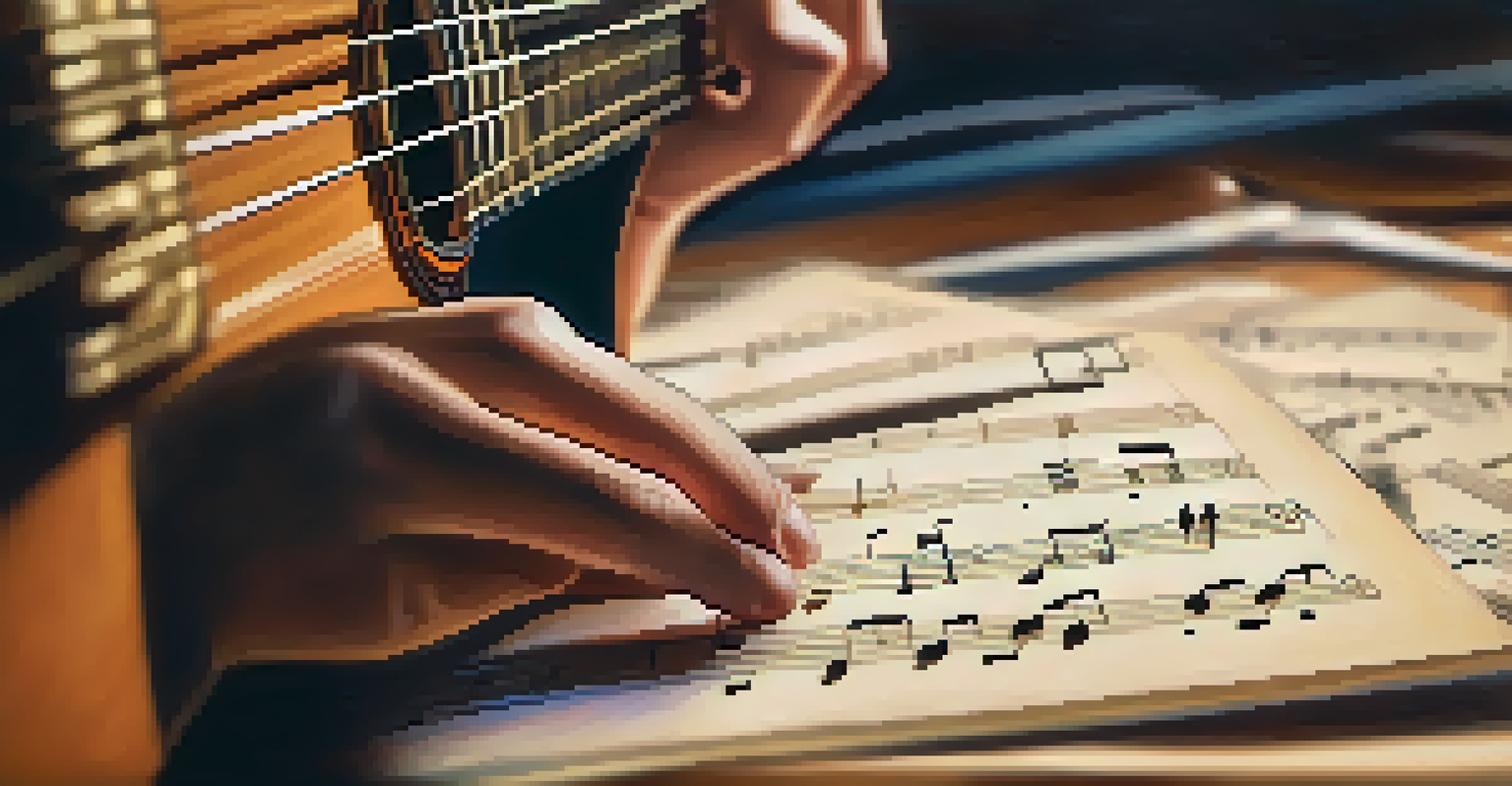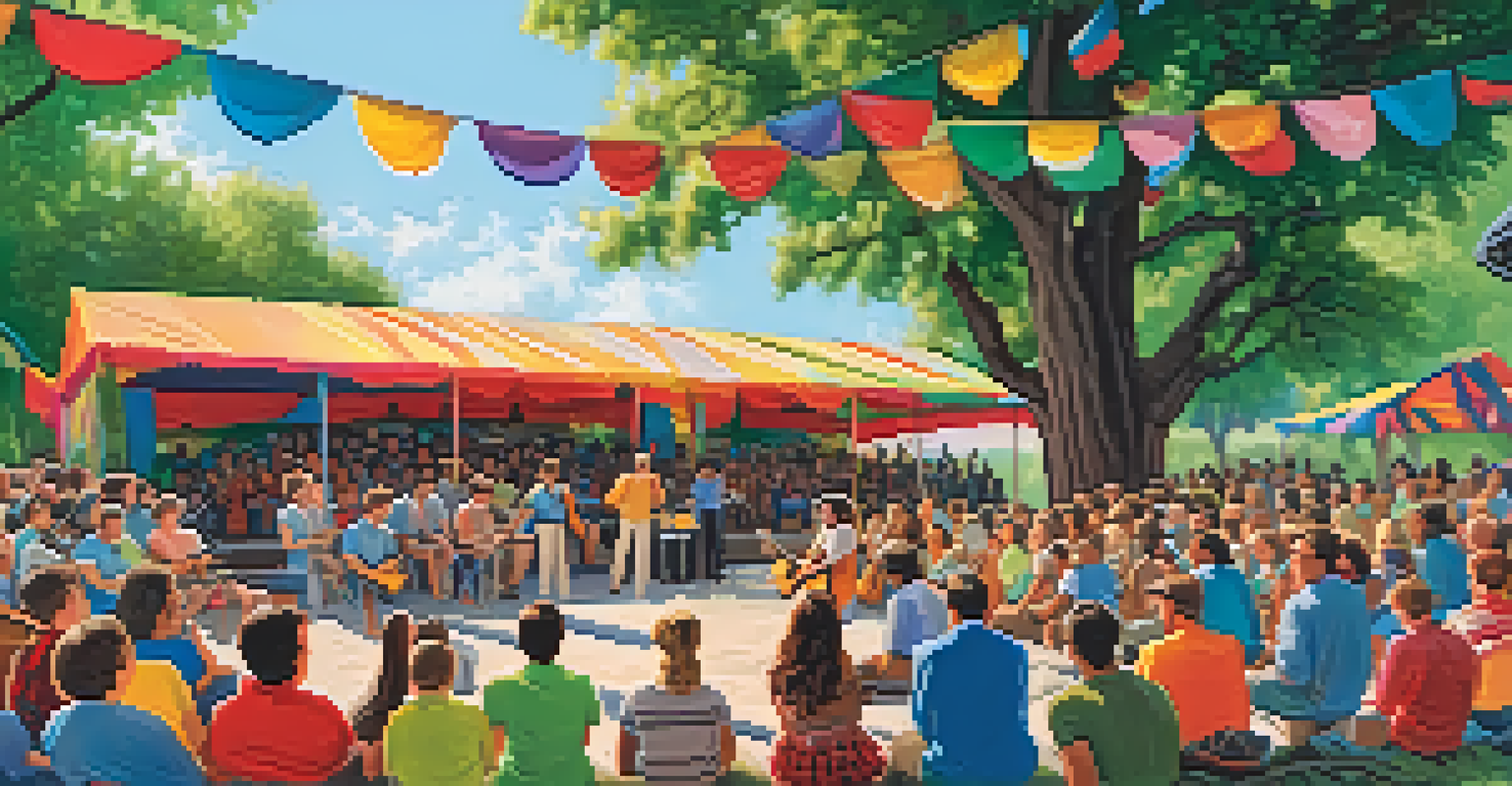Practicing Together: Tips for Guitar Ensemble Rehearsals

Establishing Clear Goals for Your Rehearsals
Before diving into practice, it's vital to establish clear goals for your ensemble rehearsals. This could range from mastering a specific piece to improving your timing as a group. Having a focus helps direct your energy and makes each session more productive.
The only way to do great work is to love what you do.
Communicate these goals with your ensemble members to ensure everyone is on the same page. This way, each player understands their role and what is expected during the rehearsal. It creates a sense of purpose that can make the experience more fulfilling for everyone involved.
As you progress, revisit these goals to assess how well you're meeting them. Adjusting your objectives based on the group's development can help maintain motivation and enthusiasm throughout your practices.
Creating a Positive and Encouraging Environment
A positive rehearsal environment can significantly impact the dynamics of your guitar ensemble. Encouragement and constructive feedback foster a sense of camaraderie, making everyone feel valued. This is especially important in group settings, where individual confidence plays a crucial role in overall performance.

Celebrate small victories, whether it's nailing a difficult chord progression or improving timing. These moments of recognition can uplift spirits and motivate players to push through challenges. Remember, everyone learns at their own pace, so maintaining a supportive atmosphere is key.
Set Clear Goals for Rehearsals
Establishing clear goals helps direct energy and ensures all ensemble members are aligned during practice.
Additionally, consider incorporating fun elements into your rehearsals. Light-hearted activities or icebreakers can relieve tension and strengthen bonds within the group, reinforcing the idea that making music together should be enjoyable.
Effective Communication Among Ensemble Members
Effective communication is the backbone of any successful ensemble rehearsal. This encompasses not only verbal discussions but also non-verbal cues like eye contact and body language. Encouraging open dialogue about musical ideas can lead to richer interpretations of the pieces you’re working on.
Alone we can do so little; together we can do so much.
During rehearsals, make it a habit to discuss what works and what doesn’t. This collaborative approach allows each member to contribute their insights, leading to better arrangements and performances. It also helps to build trust among players, which is essential for a harmonious sound.
Consider designating a 'conductor' or leader for each session. This person can help facilitate discussions and keep the group focused. Having someone steer the rehearsal can streamline communication and ensure that everyone has a chance to share their thoughts.
Incorporating Warm-Up Exercises into Rehearsals
Starting each rehearsal with warm-up exercises is crucial for both physical and mental preparation. Just like athletes stretch before a game, musicians benefit from warming up their fingers and ears. Simple scales or chord progressions can help get everyone in the right mindset for practice.
Warm-ups also serve as an opportunity to build group cohesion. When everyone plays together, it creates a unified sound that sets the tone for the rest of the rehearsal. It’s a great way to break the ice and get everyone comfortable with playing as a team.
Foster a Positive Environment
Creating a supportive atmosphere encourages camaraderie and helps musicians feel valued, enhancing overall performance.
Moreover, incorporating varied warm-up exercises can keep things fresh and engaging. Try different techniques, like fingerpicking or strumming patterns, to challenge the ensemble and enhance their skills as musicians.
Balancing Individual Practice with Group Rehearsals
While ensemble rehearsals are important, individual practice cannot be overlooked. Each musician should prioritize personal practice to ensure they are prepared for group sessions. This balance allows the ensemble to build on individual strengths while still working toward a collective goal.
Encourage members to focus on their parts outside of rehearsals, so they can contribute fully when playing together. This not only strengthens their confidence but also enhances the overall performance quality of the ensemble. A well-prepared musician can elevate the group's sound significantly.
Additionally, consider setting aside time during rehearsals for individual practice. This can give ensemble members a chance to refine their skills while still benefiting from the group's support. It creates a culture of self-improvement that ultimately benefits everyone.
Utilizing Technology for Enhanced Collaboration
In today’s digital age, technology can play a significant role in enhancing guitar ensemble rehearsals. Tools like recording software and apps can help members track progress and identify areas for improvement. By recording sessions, musicians can listen back and gain insights that may not be apparent during practice.
Moreover, online collaboration platforms can facilitate communication outside of rehearsals. Sharing sheet music, practice recordings, or even instructional videos can keep everyone engaged and informed. This approach fosters a sense of continuity and keeps the momentum going between sessions.
Balance Individual and Group Practice
Encouraging personal practice alongside ensemble rehearsals boosts individual confidence and improves the group's collective sound.
Don't forget about metronomes and tuners! These small but mighty tools can help maintain timing and ensure everyone is in tune, which is crucial for a cohesive sound. Embracing technology can modernize your rehearsals and make practice more efficient.
Performing Regularly to Build Confidence and Skills
Regular performances, whether formal or informal, can greatly enhance the growth of your guitar ensemble. These opportunities allow musicians to showcase their hard work and gain valuable experience in front of an audience. Performing can also boost confidence, which translates into better rehearsals.
Consider organizing small showcases within your community or even online performances. These events not only provide a platform for musicians to shine but also foster a sense of achievement within the ensemble. Plus, sharing music with others can deepen the bond between group members.

As you progress, aim for larger performances or competitions. This can serve as a motivating factor for the ensemble, encouraging everyone to work harder during rehearsals. The thrill of performing can be a powerful driver for improvement and teamwork.